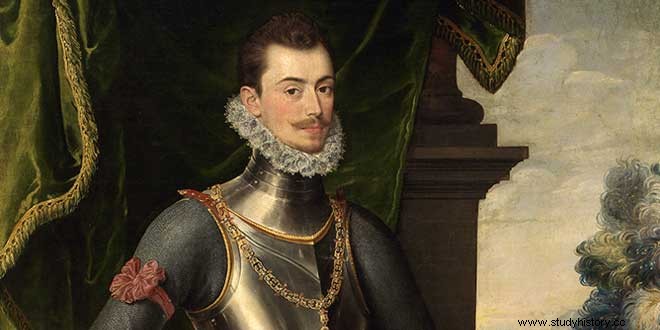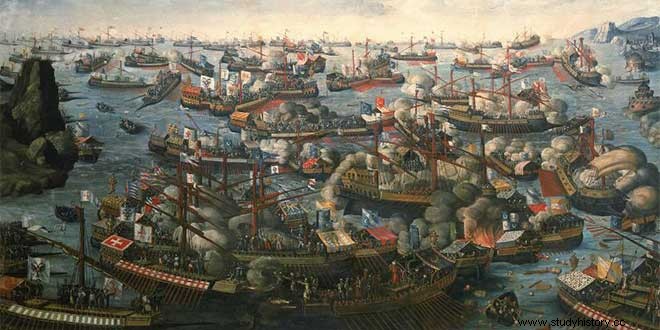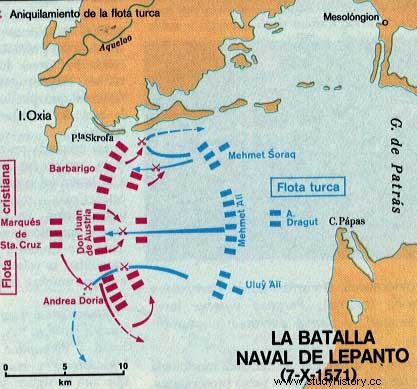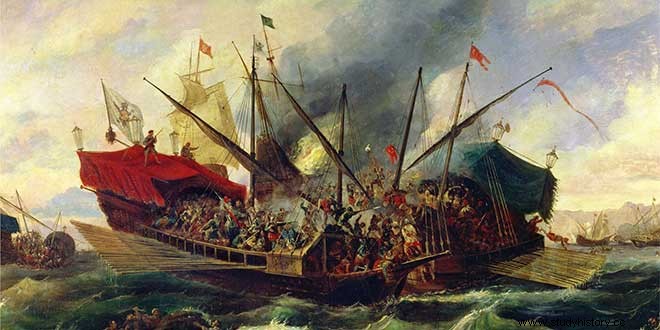The Battle of Lepanto In the last great galley battle in the Mediterranean, the combined fleet of the Western Christian powers defeated the Turkish fleet thanks to superior artillery and better-armed fighters. The Turkish losses were so great that their naval power never receded.
Data of the battle of Lepanto
Who :Philip II of Spain and Pope Pius V formed the Holy League to combat the Ottoman Turks, son of Sultan Selim II. The League fleet was under the command of John of Austria (1545-1576), while Ali Pasha (d. 1751) was at the head of the Turks.
Why :The Ottoman Turkish Empire represented a deadly threat to Italy and the rest of Europe.
Result :Christian cannonade crushed the Ottoman fleet, breaking Turkish naval power in the Mediterranean.
How :Lepanto was the greatest naval victory of Christendom against the Muslims and the last naval battle fought exclusively with oar-propelled galleys.
Where :In the Gulf of Patras, on the western coast of Greece; takes its name from the port of Lepanto (Naupaktos).
When :October 7, 1571.
Holy Leagueformation
The last Venetian stronghold, Famagusta, fell on August 1, 1571, and the Turks massacred the population and murdered the Venetian commander, Marcantonio Bragadino, who was skinned alive and his skin stuffed with straw. In response to the Turkish threat, Spain, the Holy See, Venice, Genoa and Malta had formed the Holy League on May 25, 1571 and mobilized their combined naval forces for war . Only the grave threat from the East could have compelled Venice to ally herself with her sworn enemies, Genoa and Spain, and accept a Spaniard, Don Juan of Austria, as Grand Admiral of the combined fleet. Juan was 26 years old and the illegitimate half-brother of King Philip II of Spain.

Turkish fleet transfer to Lepanto
As if he wished to increase such fears, Sultan Selim II ordered his Admiral (Kapudan Pasha) Ali Pasha to move his fleet of 274 ships (220-230 galleys) to the sheltered and fortified port of Lepanto. Ali Pasha sent his most feared commander, the dey of Algiers Uluch Ali, to attack the Italian coast and the Venetian outposts in the Adriatic . Uluch Ali was an Italian renegade from Calabria who hated Christians, with a dislike unusual even in a genuine Turk like Ali Pasha.
Unionofleaguefleets
It was therefore decided that the League, or combined fleet, should meet at Messina in August 1571. The first to arrive were the Maltese (with three galleys), whose knights were sworn enemies of the Turks, and who had already defeated to the – infidels – on their native island in 1556. They were under the command of Papal Admiral Marcantonio Colonna, who bore a personal grudge against the Turks ever since they sacked his family estate years earlier.
The fleets
Since ancient times, naval battles in the Mediterranean have been fought between oar-propelled warships, the galleys. These were long ships of pure lines with little draft, equipped with sails, although propelled in combat by rows of oars, operated by slaves or by prisoners of war who were handcuffed to their oars and went down with their galley if it went down. in combat.
The combined fleet
The combined fleet was the largest and most advanced galley fleet ever to have fought in the Mediterranean, and its commanders had introduced a series of innovations that were to win a devastating victory at Lepanto . One was to rely on artillery, and as a consequence the Christian ships had removed the reinforced stem from the bows of their hulls. Another was the introduction of boarding nets to make it more difficult for the Turks to board them. In addition, the fleet numbered six Venetian heavy galleasses, each carrying 50 heavy guns and some 500 arquebusiers. These floating artillery platforms would meet the first onslaught of the Turks and mitigate their attack.
Don Juan, who had left Barcelona on July 20 with 47 Spanish galleys, arrived in Genoa to pick up Doria's squadron six days later. This combined Spanish-Genoese contingent arrived in Messina on August 23, where the Venetians, under the command of Sebastián Veniero, had already arrived on July 23 with about 100 ships. Unfortunately, these galleys were poorly manned and maintained, and Veniero, who hated the Spanish as presumptuous and arrogant careerists, gritted his teeth and reluctantly accepted 4,000 Spanish soldiers aboard his galleys. These would be really necessary to protect your ships or board enemy galleys.
Fleet composition
The combined fleet was an impressive sight with more than 200 galleys and 22 tall ships, manned by 43,000 oarsmen and almost 13,000 sailors. Most importantly, the Christians had numerous troops on board:a total of 28,000. Of these, 7,000 were German mercenaries and 6,000 Italians, although the best equipped, heavily armored, experienced and disciplined troops were the 10,000 Spaniards . These troops would be the ones to tip the balance on the Christian side during the coming battle against the Turks. The Ottoman fleet at Lepanto was also nothing to sneeze at. It consisted of nearly 300 ships (two-thirds galleys); however, it was short of troops (only 25,000), and they were poorly equipped and armored compared to the fearsome Spanish. This deficiency, coupled with the lack of artillery, would prove fatal to the Turks.

wartips
The combined fleet under the command of don Juan arrived at the port of Corfu on September 27. The island had recently been raided and plundered by the Turks, and its state showed what might happen to Italy if the Turks ever reached its unprotected shores. The next day news arrived that the enemy fleet was anchored in the port of Lepanto.
Both sides held war councils. The Genoese admiral, Gian Andrea Doria, urged the hostile don Juan not to risk engaging in open battle . Doria's colleagues did not share his defeatism:Colonna and the Spanish admiral, Don Álvaro de Bazán, Marquis of Santa Cruz, encouraged Juan to attack. In Lepanto, most of Ali Pasha's commanders similarly advised caution, believing that the combined fleet was strong and that its crews and soldiers were thirsty for revenge after what happened in Cyprus . Only Hassán Pasha of Algiers believed that the Turks were stronger and would easily defeat the despicable and cowardly "infidels".
Layouts
On October 5, the League fleet sailed from the port of Viscando, with fog and strong winds that did not promise anything good. Obviously, if the season advanced, the weather would get so bad that there would be no chance of a galley battle on calm seas.
Fleet division
Juan divided his fleet into three divisions and decided to fight the coming battle in a line. The Venetian fleet, with 64 galleys, was on the left with Antonio and Ambrosio Bragadino commanding the two galleasses , who would break the Turkish attack with a hail of fire. On the right were the Genoese under the command of Doria, who had a number of very distinguished subordinates . Commanding three galleys was an Englishman, Sir Thomas Stukeley; Alejandro Famesio (the Duke of Parma) commanded his own contingent of troops, numbering 200; while aboard the Spanish galley Marquesa was a young bookish volunteer named Miguel de Cervantes . No one knew it then, but he would be the author of Don Quixote. The reserve division (30 galleys) was under the command of the Marquis of Santa Cruz , who would intervene to reinforce the Christian lines wherever the greatest threat of Turkish penetration arose. This left don Juan with 64 ships in the center, headed by his own captain, the Royal, a galley built three years earlier of Catalan pine, elaborately gilded, and carved with murals.
The central division of the fleets
The central division was split between the left, under the grumpy Venetian septuagenarian Sebastian Veniero, and the right, under the command of Colonna, with his Papal and Maltese ships.
During the night of October 5/6, Ali Pasha moved his fleet from Lepanto to the Gulf of Patras, while don Juan told those like Doria who still wished to avoid a battle that the time to fight had finally come.

The day of the battle of Lepanto
On the morning of that Sunday, October 7, Mass was said with special solemnity on board the Christian ships. The League fleet slipped along the northern shore of the Gulf of Patras; Coming from the east, Ali Pasha's fleet numbered 274 ships, of which just over 200 were galleys. Uluch Ali urged Ali Pasha to avoid a battle, but was pushed aside by the presumptuous Kapudan, who stated that the sultan's orders were clear:seek out and destroy the enemy wherever he might be found. Waving on Ali's captain was the green flag of the Prophet, which would guarantee victory against the "infidels".
Preparing the turkish fleet for battle
The Turkish ships were filled with the sounds of fiery martial music and the roar of trumpets, cymbals, drums, and flutes.
The Turks were formed in a huge crescent, stretching from one coast to the other; it was therefore 1 km longer than the Christian battle line. Ali would use this to try to outflank and encircle the Christian line. On board his imposing captain, the Sultana, Ali was in command of the Turkish center, with 92 galleys, while Mehmed Siroco, with his 56 Egyptian galleys, tried to outflank the Venetians by bringing their ships as close to the coast as possible. . Uluch Ali, on the left, with 63 Algerian and Turkish galleys, was facing his old adversary Doria, whom he was sure to defeat this time too.
League fleet readiness for battle
In contrast, in the Christian ships a total and solemn silence reigned. Swords were sharpened, decks were oiled to make boarding difficult, and gunsmiths cut the shackles from the feet of galley slaves:they were freed and given weapons. Not a single shot rang out as the galleasses were towed into position half a mile ahead of the main line of the fleet. Don Juan, in a frigate, rowed the line of the fleet and encouraged his men to fight to the death.
The centraldivision
When the wind changed, the Christians took it as a sign that God was on her side that day, and the Real fired a cannon shot directly at the Sultana, a sign that she could begin the fight. In fact, it had already begun when the Turkish ships that passed by the galeasses were destroyed by cannon fire; some even foundered or were so damaged by deadly fire from arquebuses and cannon that they could not move forward.
approachoftheturkishfleets
Juan had given orders not to open fire until the Turks were at point-blank range, and the Christian crews fired three volleys for each one of the Turks . Their shots reached the waterline with devastating results, while the Turks shot high, hitting only the rigging or missing the shot altogether.
Sultana's stem crashed into Real's forecastle as grappling hooks were thrown from both sides. The Janissaries were thwarted by boarding nets that allowed Spanish and Sardinian troops of the Royal to invade the deck of the Turkish galley. Brutal hand-to-hand combat flickered back and forth across the deck.
Death of Ali Pajá
Don Juan was wounded in the leg while Ali was hit in the head by an arquebus hala. Before he could get up, a Spanish soldier cut off his head and raised it on a pike. . Turkish morale collapsed at the sight of their dead Grand Admiral's head, and by 2:00 p.m. the Sultana had surrendered. The Turkish center had been defeated.

The left
Don Juan's colleagues on both sides, however, were not having it so easy. Sirocco's ships outnumbered the Venetian ones, and his admiral's captain, Agustino Barbarigo, was simultaneously attacked by eight Egyptian galleys . Barbarigo was wounded, and handed over command to his second, Federico Nani, who was shot down in turn. However, the Italian individualists did not give it importance, and continued fighting despite everything. About six Venetian galleys were sunk and it seemed that the Egyptians were going to shoot, when the Christian slaves of their galleys rebelled . Siroco was killed in close combat and his head was cut off and displayed. The Egyptians, like the Turks in the centre, were totally demoralized and many fled to the coast, where they were pursued by their enemies, who cut them down before they escaped inland. Veniero, 75 years old, gave an example of bravery to his men, telling them that it was a glorious day to die in combat.
The right
Further south, the fighting was not going so well for the Christians, and might even have jeopardized their victory, thanks to Doria's defeatism. He had a vested interest, as did his Genoese colleagues, in not losing their galleys in battle, and the Genoese commander acted accordingly. Doria hoped to outmaneuver Uluch Ali without serious combat. Uluch, however, had read his enemy's mind and extended his line (he had many more ships than Doria) even closer to the Moren coast, until Doria had stretched his fleet to the sea. absolute limit. Don Juan had seen what was happening, and he sent orders to Doria to stop extending the line to the south, otherwise he would drive a wedge between his fleet and his main one.
Uluch fleet advance
Doria (like Uluch) was arrogant and would not take orders from men he considered less intelligent than himself, so he ignored don Juan's warning. Uluch was able to exploit the superior speed of his corsair galleys, turn his ship around, and then fill the 1,000m gap that had been opened up. Before Santa Cruz or Juan himself could plug the gap, Uluch seized the initiative and exploited it for short-term advantage. If the bloodthirsty Selim, the Drunkard. his head was not to be lopped off when he returned to Constantinople, Uluch needed proof of victory.' He attacked three Maltese galleys, which had 90 knights on board, with seven of his own, concentrating on his flagship, the Capitana, under the command of Captain Pietro Giustiani, while the rest of his squadron (16 ships) attacked eight galleys. under the command of Don Juan de Cardona. Cardona lost 450 of his 500 Spanish troops and in two ships, the San Giovanni and the Piamontese (both ceded by the Duke of Savoy to Spain), not a single defender was left alive. Uluch finally took the Capitana, but Captain Ojeda (de la Guzmana) captured it again . Ojeda found that only three men remained alive, including Giustiani, and that 30 Knights of Malta had taken 300 Turks and Algerians with them to the other world.
Aftermath
Uluch escaped with a Maltese flag, although his 13 galleys were all that remained of the once-proud Ottoman fleet. By 4:00 p.m., the battle was over. Don Juan never publicly censured Doria for his conduct and mistakes, and Philip II was able, perhaps, to excuse his admiral; however, the pope, blind with fury, made it clear that the Genoese must never set foot in Rome again, on pain of being hanged like a dog. It was a complete Christian victory, albeit at a high price. The League lost 7,000 men and 12 galleys, but had freed 12,000 Christian galley slaves. Only 10,000 Turks survived the battle, in which they lost 25,000 men and 180 galleys. The Turks would take years to recover, and Europe was safe; for now.
